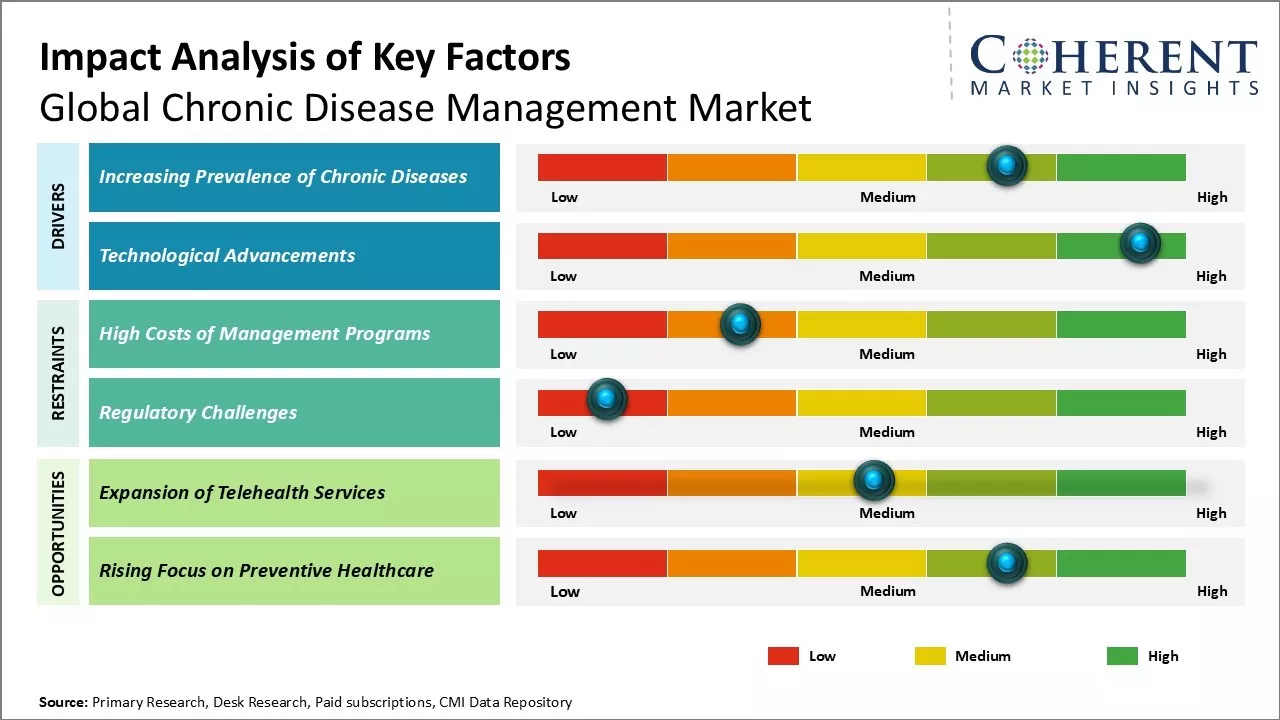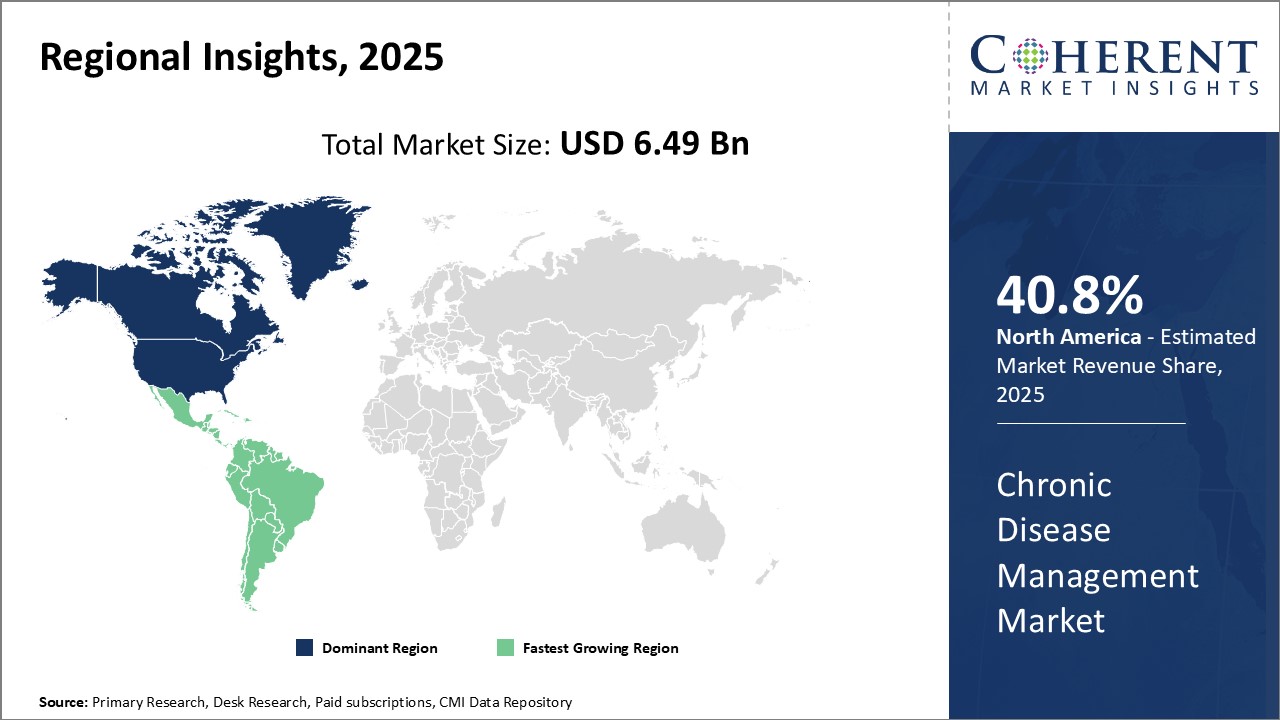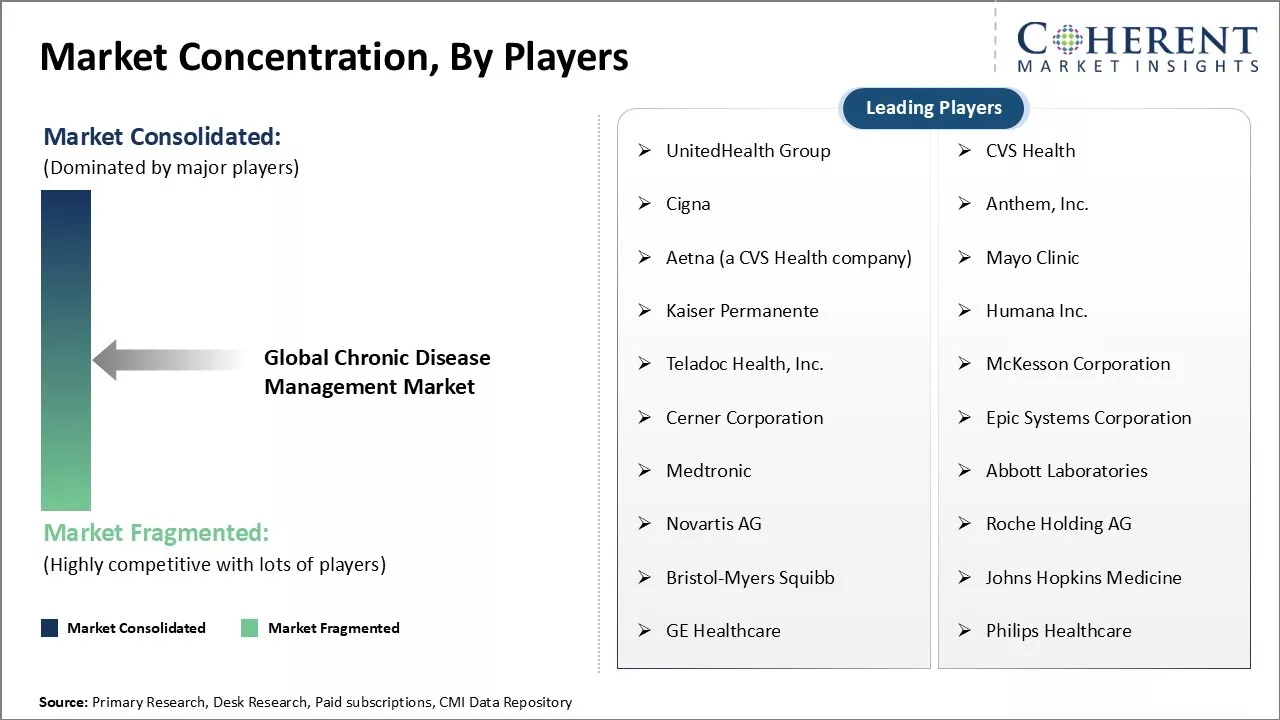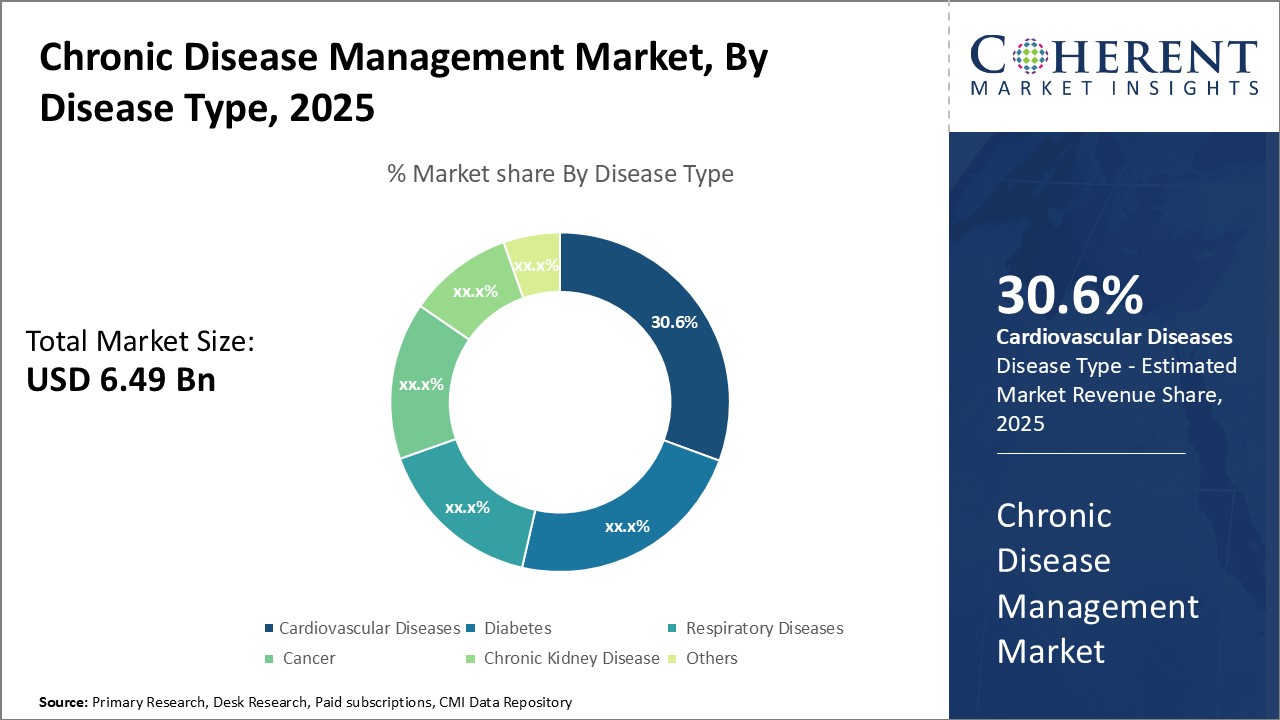Chronic Disease Management Market Size and Trends
Global chronic disease management market is estimated to be valued at USD 6.49 Bn in 2025 and is expected to reach USD 15.85 Bn by 2032, exhibiting a compound annual growth rate (CAGR) of 13.6% from 2025 to 2032.
Key Takeaways:
- By Disease Type, Cardiovascular Diseases acquired the prominent share of 30.6% in 2025 as Lifestyle and Behavioral Risk Factors.
- By Service Type, Disease Management Programs dominates the market share of 34.7% in 2025 as Rising Prevalence of Chronic Diseases.
- By Delivery Mode, On-premise segment is estimated to contribute the highest market share of 48.7% in 2025 as Enhanced Data Security and Regulatory Compliance.
- By End User, Hospitals holds the largest chronic disease market share in 2025 as Integration of Advanced Technologies.
- By Region, North America Dominates the Market share of 40.8% in 2025 as Advanced Healthcare Infrastructure.

To learn more about this report, Download Free Sample
Market Overview
Due to rising geriatric population worldwide and growing prevalence of chronic diseases such as diabetes, cardiovascular diseases, and cancer, there has been increase in need for effective chronic disease management solutions. Various market players are focusing on development of innovative digital health solutions such as remote patient monitoring services and healthcare apps to facilitate efficient chronic disease management. This can boost adoption of chronic disease management services and solutions. Furthermore, increasing healthcare costs associated with treatment of chronic diseases prompt government agencies and private insurance players to promote effective chronic disease management programs.
Current Events and their Impact on the Chronic Disease Management Market
|
Current Events |
Description and its impact |
|
Global Health Infrastructure Initiatives |
|
|
Regulatory Shifts in Telehealth Infrastructure |
|
|
WHO Chronic Disease Management Mandates |
|
Uncover macros and micros vetted on 75+ parameters: Get instant access to report
Role of AI (Artificial Intelligence) in the Chronic Disease Management Market
Artificial Intelligence (AI) plays a transformative role in the Chronic Disease Management (CDM) market by enhancing diagnosis, treatment, and patient engagement. Healthcare providers increasingly deploy AI tools to predict the onset and progression of chronic conditions such as diabetes, cardiovascular disease, and respiratory disorders. By analyzing vast datasets from electronic health records, wearable devices, and remote monitoring systems, AI enables early identification of high-risk patients, thereby allowing timely interventions.
In February 2025, Lillia, an AI startup focused on chronic care, launched its platform designed to help people with diabetes and related chronic conditions lead fulfilling lives. Lillia’s AI-driven, clinically validated platform supports healthcare providers, insurers, businesses, and public sector organizations in efficiently managing chronic diseases.
Reimbursement Policies in the Chronic Disease Management Market
In January 2025, the Punjab and Haryana High Court ruled that employees with chronic diseases are entitled to medical reimbursement from the state government, even if their treatment is administered on an outpatient basis (OPD). The court clarified that because chronic diseases require ongoing care, OPD treatment cannot be excluded from reimbursement or classified as non-emergency. This sets a precedent ensuring continuous financial support for chronic disease management without restrictions on treatment settings.
Chronic Disease Management Market Insights, by Disease Type
Cardiovascular Disease contribute the highest share of the market owing to Aging Population
Cardiovascular disease acquires the largest share of 30.6%. As people age, they become more susceptible to cardiovascular issues such as heart disease, heart attacks and strokes. Advancing age is one of the major risk factors for such chronic conditions. With improved healthcare and lifestyle standards worldwide, life expectancy has been increased over the past few decades. This has resulted in growing pool of elderly individuals prone to cardiovascular ailments. According to estimates, cardiovascular diseases account for over 17 million deaths per year globally. This number is projected to increase further with rapidly ageing population. Chronic disease management programs and remote monitoring solutions are crucial to manage the cardiovascular healthcare needs of senior citizens and help curb mortality rates from such conditions. For Instances, Cadila Pharmaceuticals introduced Empadon (Empagliflozin), that manages cardiovascular disease, marking its strategic entry into the innovative SGLT2 inhibitor therapeutic market. This is further adding to the chronic disease management market share.
Chronic Disease Management Market Insights, by Service Type
Disease Management Programs contribute the highest share of the market owing to Shift Towards Value-Based Care
As newer healthcare delivery models focus on preventive care and population health, traditional treatment of long-term conditions has proven insufficient. These multi-disciplinary programs aim to enhance outcomes through comprehensive medical and lifestyle intervention. These employ evidence-based guidelines and patient education resources to ensure safer and more effective management of chronic diseases across settings and over time. The success of disease management approaches in cutting costs and healthcare utilization has prompted greater uptake among payers, providers as well as patients. For instance, in October 2024, WebMD Ignite, a division of WebMD, introduced a new technology to help health plans manage care management initiatives. These initiatives include care coordination, preventive health education, and care planning. Through a single app, WebMD Ignite’s new service, Coach, provides members with easy access and integrates seamlessly into the workflows of health plan care administrators.
Chronic Disease Management Market Insights, by Delivery Mode
On-Premises contribute the highest share of the market owing to Operational Efficiency and Cost Management .
On Premises segment acquires the largest chronic disease market share. While cloud-based and web-based solutions enable flexibility, their dependence on reliable high-speed internet could pose challenges in implementation across diverse geographic locations. Healthcare providers with substantial resources prefer having dedicated servers and IT support for chronic disease management programs and services. This allows them to retain complete control over sensitive patient data and optimize performance as per own infrastructure capabilities. It also eliminates monthly subscription costs in the long-run. Large provider networks and integrated delivery systems especially favor on-premise deployment for synchronized multi-facility operations. This further propels the chronic diseases management market share.
Chronic Disease Management Market Insights, by End-User
Hospitals contribute the highest share of the market owing to Development of Hospital-at-Home Programs
As the main facilities for the diagnosis, treatment, and long-term care of chronic illnesses, hospitals play a crucial role in the Chronic Disease Management (CDM) market. Hospitals played a pivotal role in the management of diseases like diabetes, cardiovascular disorders, and cancer. Multidisciplinary teams made up of doctors, nurses, nutritionists, and specialists are available in hospitals, allowing for the comprehensive treatment of complicated chronic illnesses. Effective chronic disease management requires coordinated care plans, ongoing monitoring, and prompt interventions, all of which are made possible by this integrated approach. For Instances, Gleneagles Hospital Chennai introduced the "Home Care Services" program on Saturday to provide non-emergency medical care in the comfort of patients' homes. The program addresses a range of patient needs, including laboratory tests, doctor and physiotherapist consultations, nursing care, and the supply of medical consumables.
Regional Insights

To learn more about this report, Download Free Sample
North America Chronic Disease Management Market Trends
North America dominates the overall chronic disease management market with a share of 40.8%, driven by increasing prevalence of chronic illnesses such as diabetes, cardiovascular diseases, and respiratory disorders. Healthcare providers actively adopt advanced digital health technologies, including remote patient monitoring, telehealth platforms, and AI-powered analytics, to improve patient outcomes and reduce hospital readmissions. The integration of wearable devices and mobile health applications empowers patients to manage their conditions proactively. Additionally, rising awareness among patients about the importance of continuous disease management fuels demand for personalized care solutions. Besides this, the rising investment in disease management products is also acting as one of the prominent factors propelling the chronic disease management market share. For Instances, One Equity Partners invested in React Health, a North American manufacturer and distributor of respiratory, sleep, and disinfection products.
Asia Pacific Chronic Disease Management Market Trends
The Asia-Pacific chronic disease management market is experiencing significant transformation, driven by the rising prevalence of chronic conditions like diabetes, cardiovascular diseases, and respiratory disorders. Governments across the region are prioritizing digital health initiatives, exemplified by India's Ayushman Bharat Digital Mission, which aims to create an integrated digital health infrastructure. This initiative facilitates real-time health record access, promoting structured and accessible healthcare. Technological advancements, including the integration of artificial intelligence, big data analytics, and wearable devices, are enhancing personalized care and early intervention strategies. Apart from this, MSD Global Health Innovation Fund (MGHIF) invested in ekincare, an AI-powered integrated digital health gateway, led by MSD through MSD IDEA Studio Asia Pacific. This funding round will enable ekincare to advance its mission of transforming corporate primary and preventive healthcare with AI-driven, customized Outpatient Department (OPD) solutions. Such investments are expected to positively influence the chronic disease management market forecast.
United States Chronic Disease Management Market Trends
Healthcare providers are increasingly adopting digital health technologies, including remote patient monitoring, telehealth services, and artificial intelligence, to enhance patient engagement and personalize care plans. The shift towards value-based care models emphasizes prevention and early intervention, aiming to reduce long-term healthcare costs. Government initiatives, favorable reimbursement policies and growing investment on healthcare further support the implementation of chronic disease management programs. For instance, the United States spends USD 4.1 trillion annually on healthcare, with chronic disease care and management accounting for about 90% of these costs. Hospitalizations due to poorly managed conditions and medications used for treatment contribute significantly to the expense. New and improved medications for long-term illnesses could help reduce some of these costs. Additionally, the integration of wearable devices and mobile health applications empowers patients to actively manage their conditions, leading to improved health outcomes and reduced hospital readmissions.
Canada Chronic Disease Management Market Trends
The Canadian government and private sector are investing heavily in digital health initiatives to address the growing demand for innovative healthcare solutions. Telemedicine platforms, such as Maple and Dialogue, have enabled patients to receive medical consultations remotely, reducing the need for in-person visits and easing the burden on healthcare facilities. Moreover, the implementation of EHRs across Canadian healthcare institutions is revolutionizing patient data management, enabling seamless sharing of patient information among healthcare providers, improving coordination of care, and reducing medical errors. For instance, in February 2025, GreenShield, a national non-profit health and benefits organization in Canada, partnered with Saint Elizabeth Health Care (SE Health), a leading non-profit social enterprise, to launch a groundbreaking benefit that provides comprehensive coverage and care for working caregivers and their dependents. This is further propelling the chronic disease management market demand.
Market Concentration and Competitive Landscape

To learn more about this report, Download Free Sample
Chronic Disease Management Market News
- In March 2025, Morepen Laboratories Ltd. introduced a novel medication for chronic renal disease, heart failure, and Type 2 diabetes. The company presents Empamore as a high-quality, affordable alternative to existing therapies for millions of patients in India.
- In February 2025, Motilal Oswal Alternate Investment Advisors (MO Alts) made its first sole control investment by acquiring a controlling stake of over 60% in Megafine Pharma, a Mumbai-based Active Pharmaceutical Ingredient (API) company focused on exports.
- In February 2025, Byram Healthcare, part of the Owens & Minor (NYSE: OMI) family and a pioneer in home-based care, introduced ByramConnect, a customized digital health program powered by the Welldoc App®. The program uses Welldoc App’s advanced artificial intelligence to analyze member data across six health dimensions and improve outcomes for individuals with type 1 or type 2 diabetes and related chronic conditions such as cardiovascular risk, weight management, and hypertension.
- In August 2020, Cecelia Health, a company that provides virtual management for diabetes and chronic diseases, raised USD 13 million in a Series B funding round. Rittenhouse Ventures and Endo Investors co-led the round, with participation from Boston Millennia Partners, SustainVC, G100 Capital, and other investors.
Market Report Scope
Chronic Disease Management Market Report Coverage
| Report Coverage | Details | ||
|---|---|---|---|
| Base Year: | 2024 | Market Size in 2025: | USD 6.49 Bn |
| Historical Data for: | 2020 To 2024 | Forecast Period: | 2025 To 2032 |
| Forecast Period 2025 to 2032 CAGR: | 13.6% | 2032 Value Projection: | USD 15.85 Bn |
| Geographies covered: |
|
||
| Segments covered: |
|
||
| Companies covered: |
UnitedHealth Group, CVS Health, Cigna, Anthem, Inc., Aetna (a CVS Health company), Mayo Clinic, Kaiser Permanente, Humana Inc., Teladoc Health, Inc., McKesson Corporation, Cerner Corporation, Epic Systems Corporation, Medtronic, Abbott Laboratories, Novartis AG, Roche Holding AG, Bristol-Myers Squibb, Johns Hopkins Medicine, GE Healthcare, and Philips Healthcare |
||
| Growth Drivers: |
|
||
| Restraints & Challenges: |
|
||
Uncover macros and micros vetted on 75+ parameters: Get instant access to report
Chronic Disease Management Market Trend
Rising Prevalence of Chronic Diseases:
The chronic disease management market expands as more people suffer from chronic conditions like diabetes, cardiovascular diseases, and respiratory disorders. The most recent IDF Diabetes Atlas (2025) reveals that diabetes affects 11.1% of adults aged 20 to 79—meaning roughly 1 in 9 people in this age group have the disease. Additionally, more than 40% of those affected are unaware they have diabetes. Aging populations and unhealthy lifestyles significantly drive this growth. This surge creates strong demand for efficient management solutions that reduce complications, hospitalizations, and healthcare costs. Healthcare providers and payers actively implement proactive disease management programs to improve patient outcomes. Consequently, chronic disease management becomes a critical component in healthcare systems worldwide, fostering innovation and attracting investment across the sector.
Adoption of Digital Health Technologies:
Healthcare providers transform chronic disease management by adopting digital tools such as remote patient monitoring, telehealth services, and AI-based analytics. These technologies enable continuous health tracking, early detection of complications, and personalized treatment plans. Patients increase engagement through mobile apps and wearable devices, while providers gain real-time insights that enhance decision-making. The integration of electronic health records (EHRs) facilitates seamless data sharing and care coordination. Overall, digital health adoption improves efficiency, reduces hospital visits, and supports value-based care models, driving significant market growth.
Chronic Disease Management Market Opportunity
Expansion of Telehealth Services:
Market players witness growth opportunities as telehealth and remote patient monitoring services expand globally. Advancements in digital health technologies enable providers to remotely track patient vitals, symptoms, medication adherence, and conduct consultations via connected devices, mobile apps, and video conferencing. Telehealth improves access to healthcare without requiring in-person visits, reducing costs for patients and providers. As patients seek more convenient care options to manage chronic diseases from home, demand for telehealth surges. Market analysts predict telehealth could represent over 30% of the chronic disease management market by 2030. Leading healthcare organizations and technology companies actively invest in innovative virtual care solutions and remote monitoring platforms to capture this promising opportunity.
Analyst Opinion (Expert Opinion)
- The chronic disease management market reaches a pivotal moment—not merely because chronic illnesses are rising, but because traditional care models fail to curb escalating costs and deliver effective outcomes. Chronic conditions cause over 70% of global deaths annually (WHO), yet healthcare systems continue to manage them through fragmented and reactive approaches. Hospitals and payers must abandon episodic interventions and adopt continuous, tech-enabled care ecosystems.
- Healthcare providers now treat remote monitoring as a core component, not an optional add-on. The Veterans Health Administration in the U.S. cut hospital admissions by 25% through its home telehealth program, proving that virtual care doesn’t just offer convenience—it delivers better clinical outcomes. Similarly, Omada Health’s digital diabetes program helped participants achieve a 4.4% average weight loss over 12 months and maintain blood sugar control, demonstrating the real-world impact of digital therapeutics.
- Still, providers fail to meet the urgency of adoption. Only 23% of U.S. physicians regularly use remote monitoring tools (AMA 2023), exposing a dangerous implementation gap. Institutions resist—not because the technology underperforms—but because outdated workflows and reimbursement structures hinder change. Regulators must update billing codes and reward value over volume. Sweden and Singapore already lead by integrating digital monitoring, pharmacy, and primary care into single, interoperable platforms.
- Market leaders must do more than digitize broken systems—they must redesign chronic care around personalized interventions, behavioral coaching, and real-time patient engagement. The chronic disease epidemic presents a data problem disguised as a medical one. Those who tackle it with intelligence and bold redesigns—not bureaucracy—will define the next era of healthcare.
Market Segmentation
- Disease Type Insights (Revenue, USD Bn, 2020 - 2032)
- Cardiovascular Diseases
- Diabetes
- Respiratory Diseases
- Cancer
- Chronic Kidney Disease
- Others (Arthritis, etc.)
- Service Type Insights (Revenue, USD Bn, 2020 - 2032)
- Disease Management Programs
- Remote Patient Monitoring
- Telehealth Services
- Others (Diagnostic Services, etc.)
- Delivery Mode Insights (Revenue, USD Bn, 2020 - 2032)
- On-premise
- Web-based
- Cloud-based
- End User Insights (Revenue, USD Bn, 2020 - 2032)
- Hospitals
- Specialty Clinics
- Home Care Settings
- Others (Pharmaceutical Companies, etc.)
- Regional Insights (Revenue, USD Bn 2020 - 2032)
- North America
- U.S.
- Canada
- Latin America
- Brazil
- Argentina
- Mexico
- Rest of Latin America
- Europe
- Germany
- U.K.
- Spain
- France
- Italy
- Russia
- Rest of Europe
- Asia Pacific
- China
- India
- Japan
- Australia
- South Korea
- ASEAN
- Rest of Asia Pacific
- Middle East
- GCC Countries
- Israel
- Rest of Middle East
- Africa
- South Africa
- North Africa
- Central Africa
- Key Players Insights
- UnitedHealth Group
- CVS Health
- Cigna
- Anthem, Inc.
- Aetna (a CVS Health company)
- Mayo Clinic
- Kaiser Permanente
- Humana Inc.
- Teladoc Health, Inc.
- McKesson Corporation
- Cerner Corporation
- Epic Systems Corporation
- Medtronic
- Abbott Laboratories
- Novartis AG
- Roche Holding AG
- Bristol-Myers Squibb
- Johns Hopkins Medicine
- GE Healthcare
- Philips Healthcare
Sources
Primary Research interviews:
- Healthcare providers (e.g., general practitioners, endocrinologists, cardiologists)
- hospital administrators
- chronic disease care coordinators
- digital health solution providers
- public health officials.
Databases:
- World Health Organization (WHO) Global Health Observatory
- Centers for Disease Control and Prevention (CDC) Chronic Disease Indicators
- World Bank Health Data
- OECD Health Statistics
- National Health Interview Survey (NHIS)
Magazines:
- Health Affairs
- Healthcare Executive
- Managed Healthcare Executive
- Medical Economics
- MedTech Magazine
Journals:
- The Lancet Diabetes & Endocrinology
- Journal of Chronic Diseases
- American Journal of Preventive Medicine
- BMC Public Health
- International Journal of Chronic Diseases
Newspapers:
- The New York Times (Health section)
- The Guardian (Healthcare coverage)
- The Washington Post (Health & Science)
- The Times of India (Health section)
- Financial Times (Healthcare industry news)
Associations:
- American Diabetes Association (ADA)
- International Diabetes Federation (IDF)
- American Heart Association (AHA)
- European Society of Cardiology (ESC)
- World Hypertension League (WHL)
Public Domain sources:
- WHO chronic disease management guidelines
- CDC public health resources
- FDA digital health innovation initiatives
- Government health department portals (e.g., NHS UK, Health Canada)
- National Institute for Health and Care Excellence (NICE) guidelines
- Public health reports from ministries of health in key countries
- United Nations Sustainable Development Goals (SDG3 – Good Health and Well-being)
Proprietary Elements:
CMI Data Analytics Tool, and Proprietary CMI Existing Repository of information for last 8 years
Share
Share
About Author
Vipul Patil is a dynamic management consultant with 6 years of dedicated experience in the pharmaceutical industry. Known for his analytical acumen and strategic insight, Vipul has successfully partnered with pharmaceutical companies to enhance operational efficiency, cross broader expansion, and navigate the complexities of distribution in markets with high revenue potential.
Missing comfort of reading report in your local language? Find your preferred language :
Transform your Strategy with Exclusive Trending Reports :
Frequently Asked Questions
EXISTING CLIENTELE
Joining thousands of companies around the world committed to making the Excellent Business Solutions.
View All Our Clients

